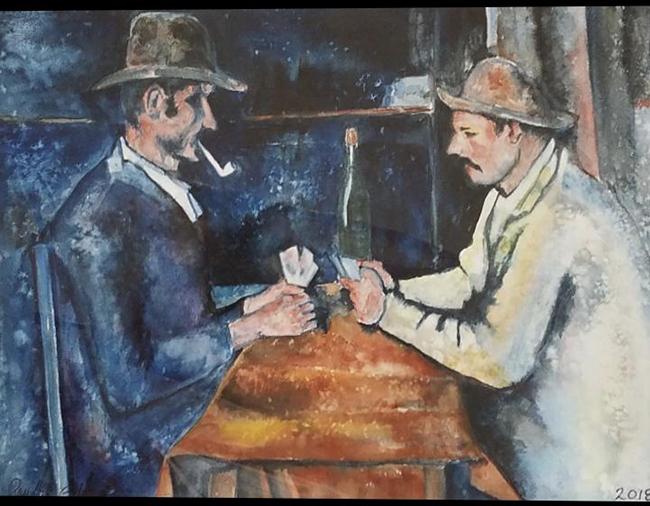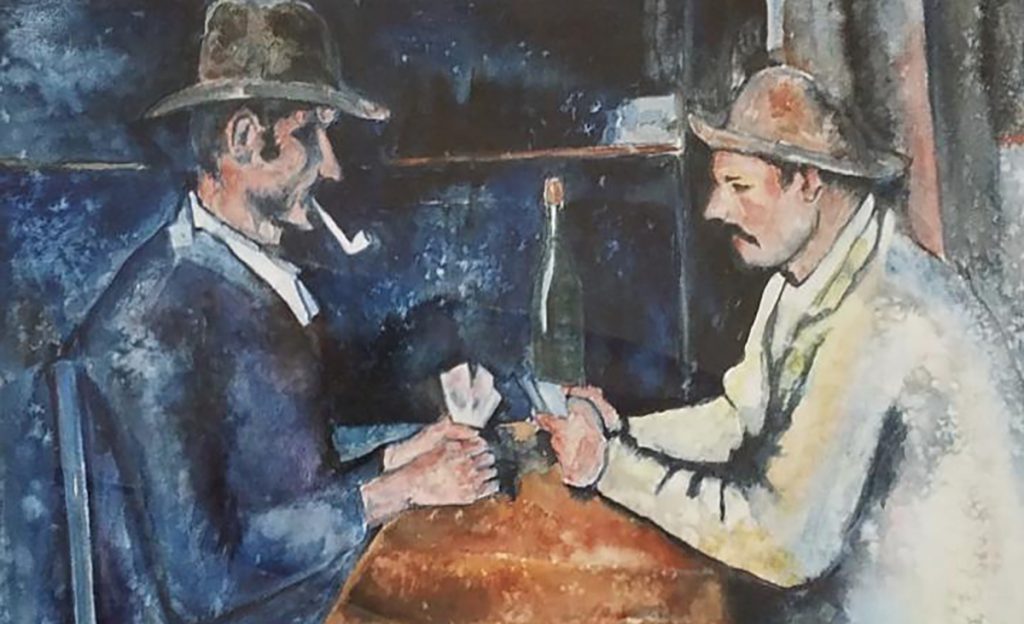Paul ‘Gilby’ Gilbertson has spent decades testing the limits of art materials. He is best known for discovering, almost by accident, the effect of salt on watercolor in the early 1970s. What began as an experiment quickly became a defining part of his style. Salt crystals react with watercolor pigments to create unpredictable bursts, textures, and blooming patterns, something Gilbertson recognized as more than a trick—it was a way to capture chance and transform it into art.
Over the years, he turned this discovery into a refined technique. At first, the salt was a background accent, but as his confidence grew, Gilbertson integrated it into the very subjects of his paintings. This blending of precision and spontaneity became his signature, making his work stand apart in exhibitions and collections. For Gilbertson, salt did not simply decorate; it revealed new dimensions in watercolor, keeping his art alive, fresh, and continually surprising.

Gilby vs Cezanne… The Card Players
In 2019, Gilbertson completed a painting he titled Gilby vs Cezanne… The Card Players. The title sets up a dialogue between himself and one of art history’s giants, Paul Cezanne. It is both a tribute and a challenge—a personal interpretation of a classic theme, filtered through Gilbertson’s salt technique and his own memories.
The backstory of this work carries unusual weight. Gilbertson originally intended to gift the painting to Prince Fahad Al-Sabah of Kuwait, someone he had crossed paths with decades earlier in Switzerland. Life had other plans; Gilbertson lost touch with the prince, and he later believed that the man had died during Desert Storm. Today, the painting hangs above his desk, a personal piece rather than a diplomatic gesture. That shift in ownership—from public offering to private reflection—adds intimacy to its presence in his home gallery.
The Card Players series by Cezanne has long been regarded as a study in stillness and focus. Painted in the 1890s, the series captures men seated at tables, absorbed in their game. Unlike the grandeur of history painting or the flourish of Impressionism, Cezanne’s work here is pared back, steady, almost sculptural in its weight. By engaging with this series, Gilbertson enters into dialogue with a painter who changed the trajectory of modern art.
Yet Gilbertson does not merely replicate. He filters Cezanne through his own material vocabulary. The salt effect plays across the canvas, disrupting the smoothness of watercolor with crystalline bursts. Where Cezanne’s brushwork builds solidity, Gilbertson’s salt textures dissolve it. The tension between control and accident is at the heart of his reinterpretation. It gives the work an added layer of Impressionistic feel, echoing light, atmosphere, and the fragility of surface.
The “salt effect” here is not a gimmick—it is integral to how Gilbertson positions himself beside Cezanne. The card game becomes less about players locked in silence and more about the material play on the surface of the painting itself. The salt intervenes, refracting pigment, making the ordinary strange. It suggests the passage of time, as though the centuries between Cezanne’s France and Gilbertson’s studio collapse into the paper, leaving behind traces of accident and intention intertwined.
Seen in person, the textures push viewers to reconsider what watercolor can do. Instead of transparent washes, we see eruptions—an impression that life itself has marked the surface. For Gilbertson, who has spent a lifetime refining this chance reaction, the salt carries both technical and metaphorical weight. It is the unpredictable, the uncontrollable, the reminder that art is not only about what the hand commands but also about what the material resists or invents.
By naming the work Gilby vs Cezanne, Gilbertson places himself in a long artistic lineage while asserting his individuality. It is not a copy but a conversation. He acknowledges Cezanne’s authority while inserting his own signature—quite literally, in the salt effect—that no one else can replicate in the same way. The result is a hybrid: respectful homage, personal memory, and technical experiment all stitched together in one piece.
Today, as the painting rests in his own home rather than in the palace of a prince, it stands as a reminder of both ambition and intimacy. It began as a diplomatic gift but became a personal statement, marking Gilbertson’s ongoing journey with salt, watercolor, and the dialogue between past and present.
In the end, Gilby vs Cezanne… The Card Players is more than a reinterpretation of a 19th-century series. It is a window into Gilbertson’s artistic philosophy: embrace chance, honor tradition, and let material surprise guide the way.

